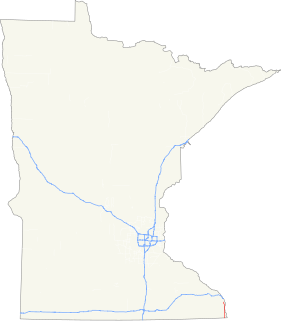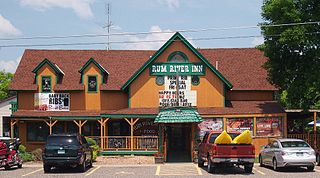
The Mississippi River is the second-longest river and chief river of the second-largest drainage system on the North American continent, second only to the Hudson Bay drainage system. From its traditional source of Lake Itasca in northern Minnesota, it flows generally south for 2,320 miles (3,730 km) to the Mississippi River Delta in the Gulf of Mexico. With its many tributaries, the Mississippi's watershed drains all or parts of 32 U.S. states and two Canadian provinces between the Rocky and Appalachian mountains. The main stem is entirely within the United States; the total drainage basin is 1,151,000 sq mi (2,980,000 km2), of which only about one percent is in Canada. The Mississippi ranks as the fourth-longest river and fifteenth-largest river by discharge in the world. The river either borders or passes through the states of Minnesota, Wisconsin, Iowa, Illinois, Missouri, Kentucky, Tennessee, Arkansas, Mississippi, and Louisiana.

Houston County is a county in the U.S. state of Minnesota. At the 2010 United States Census, the population was 19,027. Its county seat is Caledonia.

Allamakee County is the northeastern-most county in the U.S. state of Iowa. As of the 2010 census, the population was 14,330. Its county seat is Waukon.

Lansing is a city in Lansing Township, Allamakee County, Iowa, United States. The population was 999 at the 2010 census.

New Albin is a city in Iowa Township, Allamakee County, Iowa, United States. It is the northeasternmost town in Iowa, located on the Mississippi River and the Minnesota border. The population was 522 at the 2010 census.

The Stone Arch Bridge is a former railroad bridge crossing the Mississippi River at Saint Anthony Falls in downtown Minneapolis, Minnesota. It is the only arched bridge made of stone on the entire length of the Mississippi River. It is the second oldest next to Eads Bridge. The bridge was built to connect the railway system to the new Union Depot, which at that time was planned to be built between Hennepin Avenue and Nicollet Avenue. The bridge was completed in 1883, costing $650,000 at the time. 117 Portland Avenue is the general address of the historic complex.

The Anoka–Champlin Mississippi River Bridge, also known as the Ferry Street Bridge, is a 10-span open spandrel concrete deck arch bridge that spans the Mississippi River between Anoka and Champlin, Minnesota, United States. It was built in 1929 by the Minneapolis Bridge Company, replacing an 1884 bridge at the same site.

Minnesota State Highway 26 is a state highway in southeastern corner of the U.S. state of Minnesota. At 21 miles (34 km) in length, Highway 26 runs parallel to the Mississippi River and is a portion of the Great River Road. The route begins at the Iowa state line where it continues as Iowa Highway 26, and ends at an intersection with Minnesota State Highway 16 south of La Crescent.
Iowa Highway 26 is a 11-mile-long (18 km) state highway that runs from south to north in Allamakee County, Iowa. It begins in Lansing at an intersection with Iowa Highway 9 at the Black Hawk Bridge and ends at the Minnesota border at New Albin. It continues into Minnesota as Minnesota State Highway 26. Iowa 26 was created in 1969 in a numbering swap with Iowa Highway 182. The designation was changed to match TH 26. The highway is the northernmost leg of the Great River Road in Iowa. Most of the highway is designated the Driftless Area Scenic Byway.
Iowa Highway 76 is a state highway located in northeastern Iowa, most of which is in Allamakee County. The 49-mile-long (79 km) highway connects McGregor to Eitzen, Minnesota via Waukon. It begins in McGregor at an intersection with U.S. Highway 18; the first 4 1⁄4 miles (6.8 km) of the route are signed as U.S. Highway 18 Business (US 18 Bus.). It crosses into Minnesota near Eitzen and continues as Trunk Highway 76.

Fish Farm Mounds State Preserve is a 3-acre (12,000 m2) archaeological mound group containing Native American burials in the U.S. state of Iowa. It is located within the larger Fish Farms Mounds Wildlife area, a state owned hunting area a few miles south of New Albin, just inland from the Upper Mississippi River in Allamakee County.

The Village of East Davenport, also known simply as The Village, is located along the Mississippi River on the southeast side of Davenport, Iowa, United States. It was listed as a historic district on the National Register of Historic Places in 1980 as the Davenport Village. At the time of its nomination it included 145 contributing properties, most of which were working-class housing.

The Crescent Warehouse Historic District is a 10.5-acre (4.2 ha) historic district in Downtown Davenport, Iowa, United States. The district is a collection of multi-story brick structures that formerly housed warehouses and factories. Most of the buildings have been converted into loft apartments. The district was listed on the National Register of Historic Places in 2003.

Joseph Reynolds was an American entrepreneur and founder of the Diamond Jo steamboat lines, a transportation company which operated on the upper Mississippi River. In his youth, while still living in upstate New York, he operated a butchery, a general store, a grain mill, and a tannery.

Cody Road Historic District is a nationally recognized historic district located in Le Claire, Iowa, United States. It includes 60 buildings along a nine-block stretch of U.S. Route 67, Cody Road, the primary street through the town. The district contains Le Claire's main commercial district on the south side of the district and residential area on the north. The district has been listed on the National Register of Historic Places since 1979.

The West Liberty Commercial Historic District in West Liberty, Iowa, United States, is a historic district that was listed on the National Register of Historic Places in 2002. At that time, it included 41 contributing buildings, six other contributing structures, and eight non-contributing buildings.

The Joseph "Diamond Jo" Reynolds Office Building and House is a historic building located in McGregor, Iowa, United States. Joseph "Diamond Joe" Reynolds was a New York native who started working in a gristmill in the 1840s. As the grain belt moved to the west, he moved with it, settling in Chicago in the 1850s and McGregor around 1860. Because of difficulties accessing steamboats to ship grain down the Mississippi River, he established the Diamond Jo line in 1866. It grew to become a major player in the transportation industry. He had its headquarters moved from Fulton, Illinois to Dubuque, Iowa in 1874. By the late 1870s railroads had taken over as the primary means of shipping grain, and Reynolds turned his attention to passenger boats. He had this combination office and residential building constructed in 1885. Reynolds died in 1891 and his widow sold the building before her death in 1895. It has subsequently housed grain trader offices, a billiard parlor, the post office, a winery, shops, and apartments.

Diamond Jo Boat Store and Office, also known as the Dubuque Tank Terminal Co. and Inland Molasses Co. Operations Office, is a historic building located in Dubuque, Iowa, United States. This is the last remaining structure in the city that is associated with the steamboat era on the Mississippi River. Several other buildings associated with this line were destroyed in a 1909 fire. This building housed the headquarters of the Diamond Jo Packet Line from the mid-1880s until it was sold to the Streckfus Line in 1911. Originally headquartered in McGregor, Iowa, Joseph Reynolds started in the steamboat business after the American Civil War shipping wheat Minnesota and the Chicago and Northwestern railhead at Fulton, Illinois. In the last quarter of the 19th century the Diamond Jo Packet Line was one of the most active on the upper Mississippi. As railroads gradually took the freight business away from steamboats, Reynolds started to build passenger boats and he bought boats from other lines. The offices were located on the east end of the simple, two-story, brick building, and the rest was used for storage. The building was listed on the National Register of Historic Places in 1974. The structure resides at the corner of Jones and Water St. in Dubuque Iowa.

The Daniel Dayton House, also known as Ravine House, is a historic stagecoach inn in Harmony Township, Minnesota, United States. It was built in 1857 as an overnight stop on the Dubuque–St. Paul Stage Road, a frontier mail and stagecoach route through Iowa and Minnesota. The house was listed on the National Register of Historic Places in 1977 for its local significance in the themes of architecture, exploration/settlement, and transportation. It was nominated for being one of Minnesota's few surviving stagecoach inns, for its stone architecture, and for its association with the pioneer era of Harmony Township.

The Riverside Hotel is a historic former hotel in St. Francis, Minnesota, United States. It was originally built around 1860 as a residence, then expanded into a hotel beginning in 1891. This period spanned the heyday of the local lumber industry that urbanized present-day Anoka County, Minnesota. The property was listed on the National Register of Historic Places in 1979 for its local significance in the theme of commerce. It was nominated for being the only surviving commercial building dating to St. Francis's settlement as a lumber boomtown, and its association with the Woodbury family that helped found St. Francis and Anoka, Minnesota.






















